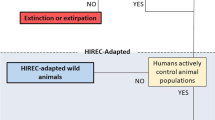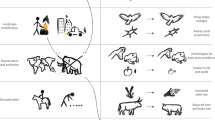Abstract
Humans intensely modify the ecosystems we inhabit. Many of the impacts that this behavior can have on other species also sharing these spaces are obvious. A prime example is the devastating current extinction crisis. Yet some populations of non-human, non-domesticated species survive or even appear to thrive in heavily disturbed or human-built habitats. Theoretically, this apparent paradox could be facilitated partly by the evolution of genetically-mediated trait adaptations to the impacts of human behavior. At the least, persistence in strongly modified habitats would provide requisite selection pressures for this process to potentially occur in the future. In fact, we have a growing number of well-characterized examples of morphological trait adaptations to human behavior. However, our knowledge of genetically-mediated behavioral adaptations in similar contexts is less well developed. In this review I set up and discuss several evolutionary scenarios by which human behavior might have impacted the evolution of genetically mediated behavior in non-human, non-domestic species and highlight several approaches that could be used in future studies of this process.
Similar content being viewed by others
References
Alberti M (2015) Eco-evolutionary dynamics in an urbanizing planet. Trends Ecol Evol 30(2):114–126
Alberti M, Marzluff J, Hunt VM (2017) Urban driven phenotypic changes: empirical observations and theoretical implications for eco-evolutionary feedback. Philos Trans R Soc Lond Ser B Biol Sci 372(1712):20160029
Alberto FJ, Boyer F, Orozco-terWengel P, Streeter I, Servin B, de Villemereuil P, Benjelloun B, Librado P, Biscarini F, Colli L et al (2018) Convergent genomic signatures of domestication in sheep and goats. Nat Commun 9(1):813
Badyaev AV, Young RL, Oh KP, Addison C (2008) Evolution on a local scale: developmental, functional, and genetic bases of divergence in bill form and associated changes in song structure between adjacent habitats. Evolution 62(8):1951–1964
Bhat U, Kempes CP, Yeakel JD (2020) Scaling the risk landscape drives optimal life-history strategies and the evolution of grazing. Proc Natl Acad Sci USA 117(3):1580–1586
Boivin NL, Zeder MA, Fuller DQ, Crowther A, Larson G, Erlandson JM, Denham T, Petraglia MD (2016) Ecological consequences of human niche construction: examining long-term anthropogenic shaping of global species distributions. Proc Natl Acad Sci USA 113(23):6388–6396
Bosse M, Spurgin LG, Laine VN, Cole EF, Firth JA, Gienapp P, Gosler AG, McMahon K, Poissant J, Verhagen I et al (2017) Recent natural selection causes adaptive evolution of an avian polygenic trait. Science 358(6361):365–368
Brown CR, Bomberger BM (2013) Where has all the road kill gone? Curr Biol 23:R233–R234
Carneiro M, Rubin CJ, Di Palma F, Albert FW, Alfoldi J, Martinez Barrio A, Pielberg G, Rafati N, Sayyab S, Turner-Maier J et al (2014) Rabbit genome analysis reveals a polygenic basis for phenotypic change during domestication. Science 345(6200):1074–1079
Ceballos G, Ehrlich PR, Barnosky AD, Garcia A, Pringle RM, Palmer TM (2015) Accelerated modern human-induced species losses: entering the sixth mass extinction. Sci Adv 1(5):e1400253
Coltman DW, O'Donoghue P, Jorgenson JT, Hogg JT, Strobeck C, Festa-Bianchet M (2003) Undesirable evolutionary consequences of trophy hunting. Nature 426(6967):655–658
Desrochers A (2010) Morphological response of songbirds to 100 years of landscape change in North America. Ecology 91(6):1577–1582
Gaynor KM, Hojnowski CE, Carter NH, Brashares JS (2018) The influence of human disturbance on wildlife nocturnality. Science 360(6394):1232–1235
Giraudeau M, Nolan PM, Black CE, Earl SR, Hasegawa M, McGraw KJ (2014) Song characteristics track bill morphology along a gradient of urbanization in house finches (Haemorhous mexicanus). Front Zool 11(1):83
Goiran C, Bustamante P, Shine R (2017) Industrial Melanism in the Seasnake Emydocephalus annulatus. Curr Biol 27(16):2510–2513 (e2512)
Harris SE, Munshi-South J (2017) Signatures of positive selection and local adaptation to urbanization in white-footed mice (Peromyscus leucopus). Mol Ecol 26(22):6336–6350
Hendry AP, Gotanda KM, Svensson EI (2017) Human influences on evolution, and the ecological and societal consequences. Philos Trans R Soc Lond Ser B Biol Sci. https://doi.org/10.1098/rstb.2016.0028
Jachmann H, Berry PSM, Imae H (1995) Tusklessness in African elephants: a future trend. Afr J Ecol 33:230–235
Johnson MTJ, Munshi-South J (2017) Evolution of life in urban environments. Science 358(6363):eaam8327
Kukekova AV, Johnson JL, Xiang X, Feng S, Liu S, Rando HM, Kharlamova AV, Herbeck Y, Serdyukova NA, Xiong Z et al (2018) Red fox genome assembly identifies genomic regions associated with tame and aggressive behaviours. Nat Ecol Evol 2(9):1479–1491
Langkilde T (2009) Invasive fire ants alter behavior and morphology of native lizards. Ecology 90(1):208–217
Law W, Salick J (2005) Human-induced dwarfing of Himalayan snow lotus, Saussurea laniceps (Asteraceae). Proc Natl Acad Sci USA 102(29):10218–10220
Librado P, Gamba C, Gaunitz C, Der Sarkissian C, Pruvost M, Albrechtsen A, Fages A, Khan N, Schubert M, Jagannathan V et al (2017) Ancient genomic changes associated with domestication of the horse. Science 356(6336):442–445
Littleford-Colquhoun BL, Clemente C, Whiting MJ, Ortiz-Barrientos D, Frere CH (2017) Archipelagos of the Anthropocene: rapid and extensive differentiation of native terrestrial vertebrates in a single metropolis. Mol Ecol 26(9):2466–2481
Marciniak S, Perry GH (2017) Harnessing ancient genomes to study the history of human adaptation. Nat Rev Genet 18(11):659–674
McDonnell MJ, Hahs AK (2015) Adaptation and adaptedness of organisms to urban environments. Annu Rev Ecol Evol Syst 46:261–280
Miranda AC, Schielzeth H, Sonntag T, Partecke J (2013) Urbanization and its effects on personality traits: a result of microevolution or phenotypic plasticity? Glob Chang Biol 19(9):2634–2644
O'Dea A, Shaffer ML, Doughty DR, Wake TA, Rodriguez FA (2014) Evidence of size-selective evolution in the fighting conch from prehistoric subsistence harvesting. P Roy Soc B Biol Sci 281(1782):20140159
Pelletier F, Coltman DW (2018) Will human influences on evolutionary dynamics in the wild pervade the Anthropocene? BMC Biol 16(1):7
Pendleton AL, Shen F, Taravella AM, Emery S, Veeramah KR, Boyko AR, Kidd JM (2018) Comparison of village dog and wolf genomes highlights the role of the neural crest in dog domestication. BMC Biol 16(1):64
Perry GH (2014) Parasites and human evolution. Evol Anthropol 23(6):218–228
Phillips BL, Shine R (2004) Adapting to an invasive species: toxic cane toads induce morphological change in Australian snakes. Proc Natl Acad Sci USA 101(49):17150–17155
Pigeon G, Festa-Bianchet M, Coltman DW, Pelletier F (2016) Intense selective hunting leads to artificial evolution in horn size. Evol Appl 9(4):521–530
Purdue JR (1989) Changes during the Holocene in the size of white-tailed deer (Odocoileus virginianus) from Central Illinois. Quaternary Res 32(2):307–316
Richard AF, Goldstein SJ, Dewar RE (1989) Weed macaques: the evolutionary implications of macaque feeding ecology. Int J Primatol 10:569–594
Rolshausen G, Segelbacher G, Hobson KA, Schaefer HM (2009) Contemporary evolution of reproductive isolation and phenotypic divergence in sympatry along a migratory divide. Curr Biol 19(24):2097–2101
Sanchez-Villagra MR, Geiger M, Schneider RA (2016) The taming of the neural crest: a developmental perspective on the origins of morphological covariation in domesticated mammals. R Soc Open Sci 3(6):160107
Sullivan AP, Bird DW, Perry GH (2017) Human behaviour as a long-term ecological driver of non-human evolution. Nat Ecol Evol 1:0065
Thawley CJ, Goldy-Brown M, McCormick GL, Graham SP, Langkilde T (2019) Presence of an invasive species reverses latitudinal clines of multiple traits in a native species. Glob Chang Biol 25(2):620–628
Thomsen EK, Koimbu G, Pulford J, Jamea-Maiasa S, Ura Y, Keven JB, Siba PM, Mueller I, Hetzel MW, Reimer LJ (2017) Mosquito behavior change after distribution of bednets results in decreased protection against malaria exposure. J Infect Dis 215(5):790–797
Turcotte MM, Araki H, Karp DS, Poveda K, Whitehead SR (2017) The eco-evolutionary impacts of domestication and agricultural practices on wild species. Philos Trans R Soc Lond B Biol Sci 372(1712):20160033
van Dongen WF, Robinson RW, Weston MA, Mulder RA, Guay PJ (2015) Variation at the DRD4 locus is associated with wariness and local site selection in urban black swans. BMC Evol Biol 15:253
Van't Hof AE, Campagne P, Rigden DJ, Yung CJ, Lingley J, Quail MA, Hall N, Darby AC, Saccheri IJ (2016) The industrial melanism mutation in British peppered moths is a transposable element. Nature 534(7605):102–105
Wang X, Pipes L, Trut LN, Herbeck Y, Vladimirova AV, Gulevich RG, Kharlamova AV, Johnson JL, Acland GM, Kukekova AV et al (2018) Genomic responses to selection for tame/aggressive behaviors in the silver fox (Vulpes vulpes). Proc Natl Acad Sci USA 115(41):10398–10403
Wilkins AS, Wrangham RW, Fitch WT (2014) The "domestication syndrome" in mammals: a unified explanation based on neural crest cell behavior and genetics. Genetics 197(3):795–808
Winchell KM, Reynolds RG, Prado-Irwin SR, Puente-Rolon AR, Revell LJ (2016) Phenotypic shifts in urban areas in the tropical lizard Anolis cristatellus. Evolution 70(5):1009–1022
Worm B, Paine RT (2016) Humans as a Hyperkeystone species. Trends Ecol Evol 31(8):600–607
Acknowledgements
I thank Catharine Rankin for the invitation to participate in the President’s Symposium at the wonderful International Congress of Neuroethology 2018. I enjoyed great discussions with many of the conference attendees, receiving valuable feedback that contributed to this paper. My work on this topic is supported by a grant from the National Science Foundation (BCS-1554834). Any opinions, findings, and conclusions or recommendations expressed in this material are those of the author and do not necessarily reflect the views of the National Science Foundation. I am also supported by the German Research Foundation (DFG FOR 2237; Project “Words, bones, genes, tools: Tracking linguistic, cultural, and biological trajectories of the human past”).
Author information
Authors and Affiliations
Corresponding author
Ethics declarations
Conflict of interest
The author declares that he has no conflict of interest.
Additional information
Publisher's Note
Springer Nature remains neutral with regard to jurisdictional claims in published maps and institutional affiliations.
Rights and permissions
About this article
Cite this article
Perry, G.H. How human behavior can impact the evolution of genetically-mediated behavior in wild non-human species. J Comp Physiol A 206, 337–342 (2020). https://doi.org/10.1007/s00359-020-01415-9
Received:
Revised:
Accepted:
Published:
Issue Date:
DOI: https://doi.org/10.1007/s00359-020-01415-9




